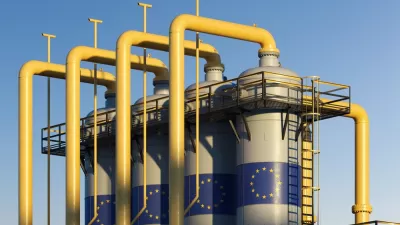You'd never know it from the hype on rising gas prices, but the U.S. is moving toward that elusive goal of oil independence due to the convergence of two factors: falling oil consumption and increasing domestic production over the last half-decade.
Clifford Krauss and Eric Lipton focus on the national security implications that result from the country's declining imports of oil, but they also report on the costs to the environment resulting from the increased oil and natural gas drilling.
"In 2011, the country imported just 45 percent of the liquid fuels it used, down from a record high of 60 percent in 2005. National oil production, which declined steadily to 4.95 million barrels a day in 2008 from 9.6 million in 1970, has risen over the last four years to nearly 5.7 million barrels a day."
"There is no question that many national security policy makers will believe they have much more flexibility and will think about the world differently if the United States is importing a lot less oil," said Michael A. Levi, an energy and environmental senior fellow at the Council on Foreign Relations.
Declining Consumption
"Just since 2007, consumption of all liquid fuels in the United States, including diesel, jet fuel and heating oil, has dropped by about 9 percent, according to the Energy Department. Gasoline use fell 6 to 12 percent, estimated Tom Kloza, chief oil analyst at the Oil Price Information Service."
Increased Oil Production Comes at a Cost
"Greater energy independence is "a prize that has long been eyed by oil insiders and policy strategists that can bring many economic and national security benefits," said Jay Hakes, a senior official at the Energy Department during the Clinton administration. "But we will have to work through the environmental issues, which are a definite challenge."
Indeed, "Mr. Obama's current policy has alarmed many environmental advocates who say he has failed to adequately address the environmental threats of expanded drilling and the use of fossil fuels." For example, "the Interior Department was granted the power to issue drilling permits on millions of acres of federal lands without extensive environmental impact studies for individual projects..."
Thanks to Mark Boshnack
FULL STORY: The Energy Rush: U.S. Is Inching Toward Elusive Goal of Energy Independence

Planetizen Federal Action Tracker
A weekly monitor of how Trump’s orders and actions are impacting planners and planning in America.

San Francisco's School District Spent $105M To Build Affordable Housing for Teachers — And That's Just the Beginning
SFUSD joins a growing list of school districts using their land holdings to address housing affordability challenges faced by their own employees.

The Tiny, Adorable $7,000 Car Turning Japan Onto EVs
The single seat Mibot charges from a regular plug as quickly as an iPad, and is about half the price of an average EV.

Seattle's Plan for Adopting Driverless Cars
Equity, safety, accessibility and affordability are front of mind as the city prepares for robotaxis and other autonomous vehicles.

As Trump Phases Out FEMA, Is It Time to Flee the Floodplains?
With less federal funding available for disaster relief efforts, the need to relocate at-risk communities is more urgent than ever.

With Protected Lanes, 460% More People Commute by Bike
For those needing more ammo, more data proving what we already knew is here.
Urban Design for Planners 1: Software Tools
This six-course series explores essential urban design concepts using open source software and equips planners with the tools they need to participate fully in the urban design process.
Planning for Universal Design
Learn the tools for implementing Universal Design in planning regulations.
Smith Gee Studio
City of Charlotte
City of Camden Redevelopment Agency
City of Astoria
Transportation Research & Education Center (TREC) at Portland State University
US High Speed Rail Association
City of Camden Redevelopment Agency
Municipality of Princeton (NJ)





























